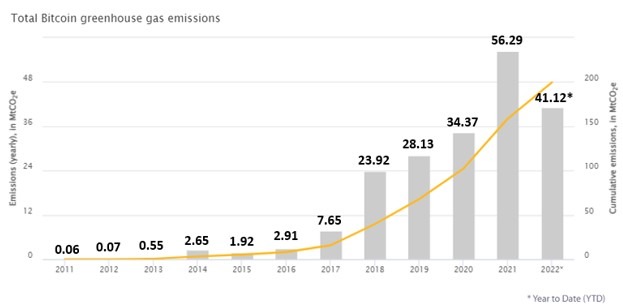
Bitcoin’s carbon footprint dropping 14% in 2022, electricity consumption declining 1.1%
An index by the Cambridge Centre for Alternative Finance (CCAF) estimates that 199.65 MtCO2e can be attributed to the Bitcoin network since its inception.
The amount of greenhouse gas emissions produced by Bitcoin mining has dropped 14% this year, while estimated annual electricity consumption declined 1.1%, an analysis by the Cambridge Centre for Alternative Finance (CCAF) – a research centre at Cambridge Judge Business School – reveals.
According to their Cambridge Bitcoin Electricity Consumption Index (CBECI) – that provides estimates on the greenhouse gas emissions and overall environmental footprint on a day-to-day basis related to Bitcoin –, cryptocurrency produced current greenhouse gas emissions of 48.35 million tonnes of carbon dioxide equivalent (MtCO2e) as of September 21th 2022, or 0.10% of global greenhouse gas emissions, similar to the emissions of countries such as Nepal (48.37 MtCO2e) and the Central African Republic (46.58 MtCO2e), or about half that of gold mining (100.4 MtCO2e). This estimate for the current annualised emissions is about 14% lower than estimated emissions of 56.29 MtCO2e in 2021. The index estimates that by mid-September 2022 (21/09/2022), approximately 199.65 MtCO2e can be attributed to the Bitcoin network since its inception.

The tool also show that comparing the growth of Bitcoin network hashrate and estimated annual electricity consumption between Jan 1st 2021 and Sep 21th 2022, hashrate increased from 137.76 EH/s to 242.13 EH/s (+75.8%), while estimated annual electricity consumption declined from 96.48 TWh to 95.42 TWh (-1.1%). Ultimately, researchers attribuites the annual GHG emissions estimate being fairly below the 2021 to a shift to more efficient hardware by Bitcoin miners due to the recent sharp decline in mining revenue per unit of computing power provided.
The tool also provides more detailed information on Bitcoin’s electricity mix, finding that fossil fuels account for almost two-thirds of the total electricity mix (62.4%) and sustainable energy sources just 37.6% (of which 26.3% are renewables and 11.3% nuclear). The estimate thus noticeably deviate from industry findings that estimate the share of sustainable energy sources in Bitcoin’s electricity mix to be 59.5%.
Launched in July 2019, the Cambridge Bitcoin Electricity Consumption Index (CBECI) also provides a Mining Map, showing the geographical distribution of the hashrate (the computational power provided to the network) over time.





